Euro Nymphing For Steelhead: Methods And Tips Of The Guides
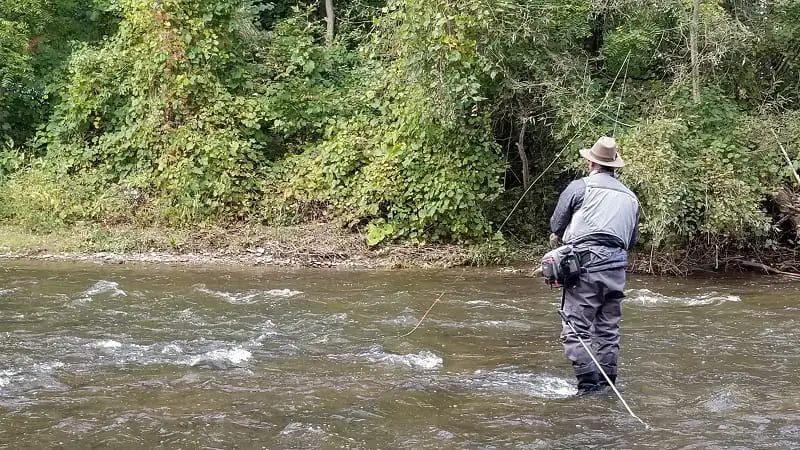
Euro Nymphing for steelhead can often be the most effective way to catch steelhead in certain types of water, and there are many river guides like myself and also experienced anglers that are now using Euro Nymph methods for steelhead.
I have been teaching and using Euro Nymphing methods to catch steelhead since about 2008, and this article is packed with advice and tips, my leader setups, my best flies, and tactics that will help you understand this new method and help you catch more steelhead.
The reason Euro Nymphing is so effective is that it allows you to get your flies down to the steelhead fast, it allows you to control your speed and get the most natural drift possible, and it allows you to detect even the most subtle bites.
Euro Nymphing often requires special Euro nymph flies or at least variations of the regular flies that are usually effective for steelhead, but I will show you how you can Euro Nymph for steelhead with your regular non-weighted flies or a combination of both.
Euro Nymphing is also called tight line nymphing and modern nymphing.
We may make a small commission from some of the links on this website, which is at no cost to you. I appreciate your support.
Best Water To Euro Nymph For Steelhead
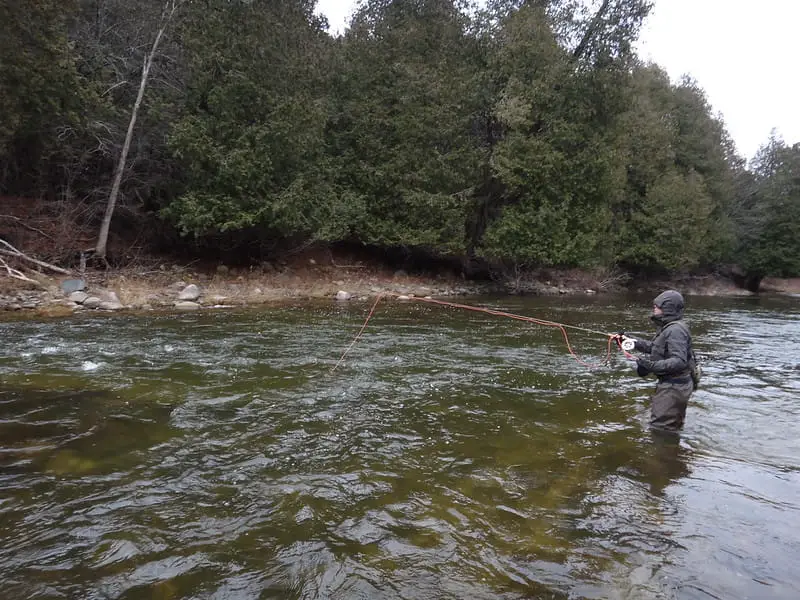
Not all water is good for the Euro Nymph method, and often, I prefer to use indicator nymphing in slow, flat, or very deep water.
However, it’s hard to beat Euro Nymphing in faster water that is less than 6 feet deep. The Euro nymph method excels when fishing for steelhead in pocket water, runs, and riffles. It is also great in short pools and when you can fish within 20 feet of your rod tip.
What Makes Euro Nymphing For Steelhead So Effective
What the expert competition fly anglers that Euro nymph for trout will tell you, and what I tell my clients is, what makes Euro nymphing for steelhead so effective is the ability to control the speed and depth of your fly better than other nymphing methods.
Generally, for any fly fishing for steelhead, you need to control the speed of your fly, but when imitating dead drifting food like eggs and nymphs, it’s even more important.
Speed Control Is Better When Euro Nymphing
When Euro Nymphing you are not using any type of float or indicator that might pull or drag your fly. This allows the flies to move at the speed of the bottom current which gives you the most natural drift speed possible. Natural speed results in more steelhead.
I’ve guided around 3000 anglers, and in my opinion, the speed of your fly might be the most critical aspect to master if you want to catch ten-times more steelhead.
Most anglers are not aware that the bottom current where the steelhead are feeding is often much slower than the upper current. The upper current is sometimes 50 to 90% faster than the bottom current.
I discuss why, how I know this, proof, and some tips for speed control in my article Dead Drift Nymphing: Speed Control
Depth Control Is Better When Euro Nymphing
The other great thing about Euro nymphing steelhead is the ability to control your depth and to be able to fish in shallow and deep water without any setup or indicator adjustments. You simply lift the tip up or lower the tip down to get the right depth.
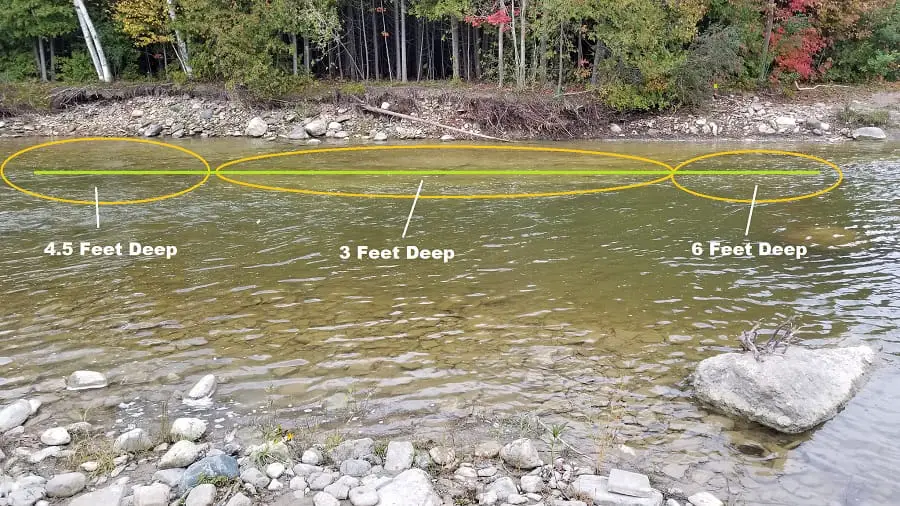
With a strike indicator, you would need to adjust the indicator for all the different depths of a pool and you would need to fish each depth separately. In the picture above I would need to adjust my indicator 5 or 6 times to fish this pool otherwise I would be too deep or too shallow at times.
With euro nymphing steelhead I would not need to make any adjustments to my setup and I would simply raise or lower my rod tip as needed.
As I run my drift through the river with my Euro Nymphing set up, once my fly starts to hit the bottom I simply lift my rod tip to keep the fly 6 to 12 inches above the bottom or lower it when I’m not hitting the bottom.
The Euro method makes it easier to find the bottom and then fish in the strike zone.
Strike Detection Is Better When Euro Nymphing
Another great benefit is that your strike detection is improved. If done right, you will never have slack in your presentation which means anything that touches your flies will be noticed on what we call the sighter.
The Sighter
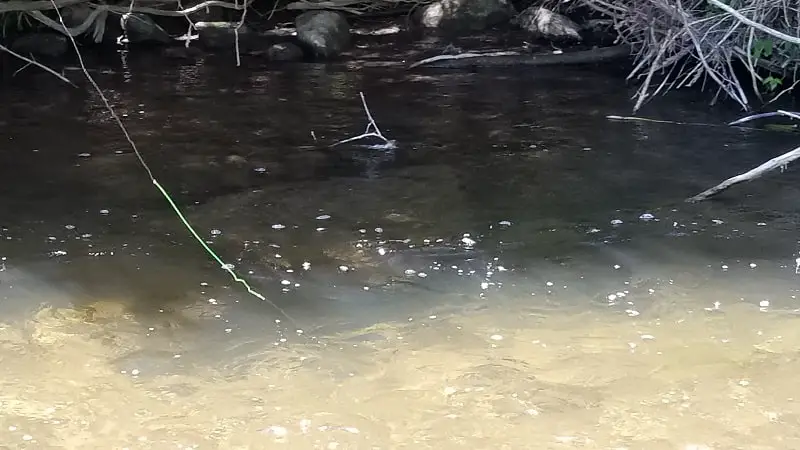
There are two things that make Euro Nymphing steelhead unique to other nymphing methods for steelhead. The weighted flies and the sighter.
The sighter is the brightly colored piece of line in the leader setup that makes all of this possible. The sighter can be one color or 2 or 3 colors and it can be anywhere from 6 inches to a few feet.
Most sighters that guys use are brightly colored to help them see it, however, you can also get sighters that are white and black and the contrasting colors can also help you see it better. There are also sighters that I use that stand out better and tricks that I use to make all sighters easier to see.
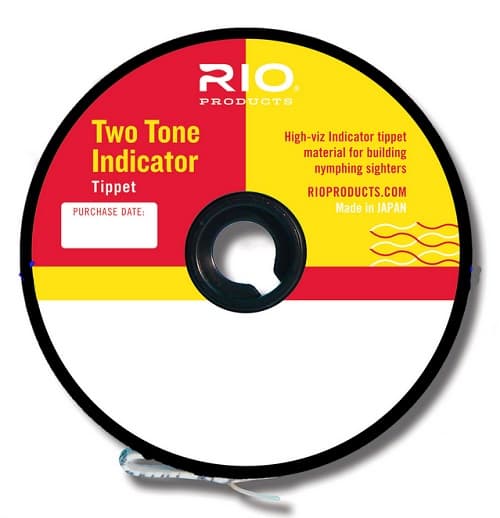
When I Euro Nymph for steelhead my sighter is usually around 14 to 18 inches long, but I have been known to use 8 inches and up to 24 inches.
My favorite sighter material is the 1X RIO Two-Tone Indicator Tippet in the Pink/Yellow color. It also comes in White/Black.
Another good sighter is the 0X tri-color Orvis Tactical Sighter Tippet, which has Chartreuse/Orange/White segments, and I like the OX thickness, which is more visible than the 1X Rio. See Best Price Now
Sometimes the sigher is hard to see for some people due to poor eyesight or glare on the water. If this happens, I have a few guide tricks up my sleeve to help my clients out. Because, after all, the sighter is key to the whole setup, and if you can’t see it, you won’t do well.
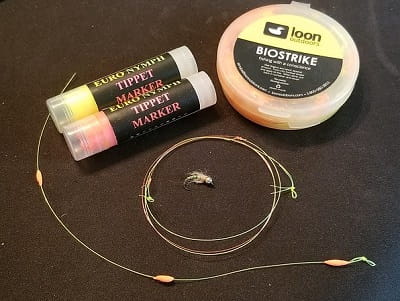
GUIDE TIP: One of my best tricks to help guys see the sighter better is to apply micro pieces of Loon Bio-Strike Putty to the sighter.
I prefer the orange color, and I add two or three small blobs pinched tightly to the bottom part of the sighter. You can see the three little blobs on the leader in the picture.
My blobs of putty are about the size and shape of a cooked grain of rice but making them a little more round can work too. You can increase the size as needed as long as it does not weigh the sighter down and cause problems. These blobs can easily be added or removed.
Another type of sighter that I have used with success when guiding anglers when they can’t see the sigher is 20 or 30-pound yellow or orange dacron fly line backing like Rio Dacron Fly-Line Backing.
Fly line backing is thicker so it’s much easier to see and it’s still very supple. The only disadvantage of using fly line backing it is that it might absorb water, which makes it heavy and it might start to sag. To prevent sag, I will often lightly coat the sighter with Mucilin Paste or Loon Payette Paste.
GUIDE TIP: Mucilin and Payette paste have a lot of great uses, and I always have one or the other, or usually both in my fishing pack.
I will discuss where in the Euro leader the sighter should be placed and what you need to make my Euro Nymphing leader below in this article.
Do You Need A Euro Nymphing Line?
Many companies are now selling fly lines specifically for the euro nymphing purpose which are called Euro Nymph fly lines. Because of this, many anglers that are new to
Anglers, will ask me if they need to have a Euro Nymphing fly line for steelhead and the simple answer is NO.
You do not need a Euro Nymph line for steelhead because you can use a special leader that is up to 40 feet long which allows you to Euro Nymph very effectively for steelhead with any line.
However, there are some Nymphing methods or variations that require the line to be out of the rod guides, and therefore using a specially made Euro fly line will make these Euro methods easier, and for these methods, many anglers prefer a Euro Nymph line over a regular fly line.
Some anglers prefer a Euro Nymph line over a regular fly line for a couple of reasons.
The disadvantage to using a regular fly line (with a short leader), especially if it’s a weight forward fly line, is that the tip of the fly line is heavy and if you have too much fly line hanging out of the rod guides it will sag between your rod tip and the sighter.
This sagging effect can cause the fly to pull inwards or downriver too fast. For this reason, either a Euro line or, my extra-long Euro steelhead leader (which I’ll show you below) will prevent sag and unwanted pulling.
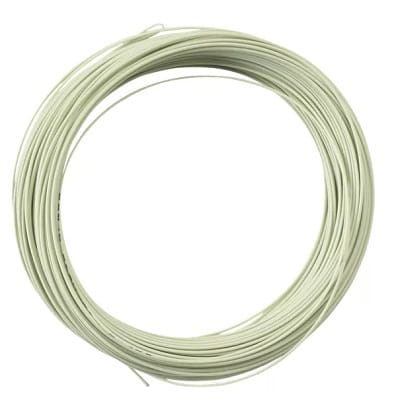
The other reason or disadvantage to a weight forward line is that the heavy fly line can also cause sagging between your reel and the first feeder guide up the rod.
This is a bad thing when you set the hook because you always want tension from the reel to your bottom fly when you Euro Nymph for steelhead, and slack anywhere in the line, including above the reel in the rod guides, can be a problem.
Euro nymph lines like the Orvis Hydros Tactical Nymph Fly Line are extra thin, lightweight, and more sensitive, and that can prevent these issues and should be considered when nymphing steelhead.
CAUTION: At this time, many Euro lines are not made for big strong fish like steelhead, and they are also not made for 7 to 9-weight fly rods. This may change as this method becomes more popular.
The downside is that often Euro lines are only made in 6 weight size or under, and they can have a breaking strength less than 15 pounds.
As an example, The 5wt Rio Shorty line, which I discuss below, only has a rating of 12-pound test. Therefore, it’s not recommended to apply too much pressure when fighting a fish or pulling out a snag.
For the above reason, I rarely recommend Euro lines for steelhead. Instead, I use and recommend a super long leader mane from mono or OPST, see that below. That super-long leader eliminates the above-mentioned issues with sag.
Alternatives To Euro Nymphing Lines For Steelhead
A good alternative to getting a full Euro nymphing fly line is the RIO Euro Nymph Shorty Fly Line which is a 20-foot Euro line extension that attaches to any standard fly line and converts it to a Euro line. See Best Price Now.
The Rio Shorty line has the advantage of enabling the angler to remove the shorty line and switch to other methods like Indicator Fishing, or Streamer Fishing For Steelhead, which is much better done with a standard weight forward line.
My preferred Euro Nymphing rig for steelhead is to use a Mono-Rig setup combine/attached to about 20 feet of OPST Pure Lazar Line, which is attached to the fly line. I use the 30-pound green Lazar line and I attach it directly to my standard steelhead fly line using a loop-to-loop connection or and nail knot connection.
The mono leader, in this case, is usually around 16 to 18 feet attached to the 30-foot Lazar line. See that leader set-up below. This allows me to make 40-foot casts if needed.
The OPST line is made for fishing steelhead as a running line for Spey lines, but it is the best line I have found for long leader Euro methods, and many other tight line nymphing guides and anglers are using it too. It’s very much like a thicker monofilament line.
Also, since I use the very productive French Nymphing or Spanish Nymphing methods for steelhead, I never use any fly line while fishing. Therefore the fly line is irrelevant and unused until a big steelhead pulls it off my reel.
The advantage to using a standard weight forward line when Euro Nymph fishing for steelhead is that a standard weight forward line can also be easily used for indicator or streamer fishing if you want to change methods without changing reels.
Do You Need A Euro Nymphing Rod For Steelhead
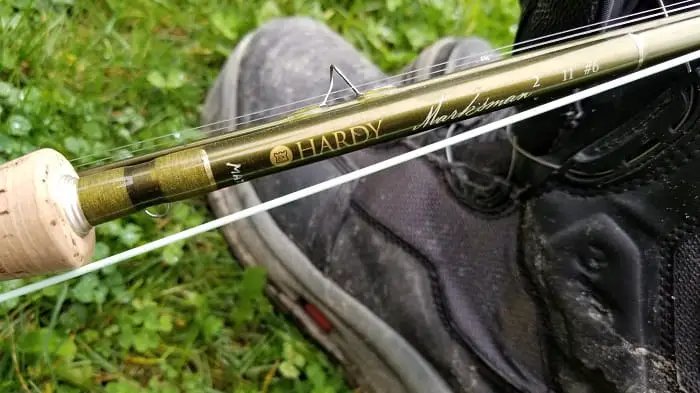
There are many Euro nymphing rods on the market for trout, but there are few on the market that are good for steelhead.
You do not need a Euro Nymphing rod to Euro Nymph for steelhead. A standard 9-foot or 10-foot fly rod will work. However, there are some advantages to a rod that is specifically designed for euro nymph methods that will make it easier to fish with.
I tell my clients that if you can find a good 10 to 11-foot single hand fly rod that is a 6 to 8-weight I highly recommend getting it.
The longer Euro rods allow you to get longer casts, fish longer leaders with better line control, and the long rods also protect light tippets. Another observation I have made from trying many Euro nymph rods from $200 to over $1000 is they are built with a softer more sensitive tip section that allows the angler to cast smaller and lighter flies further.
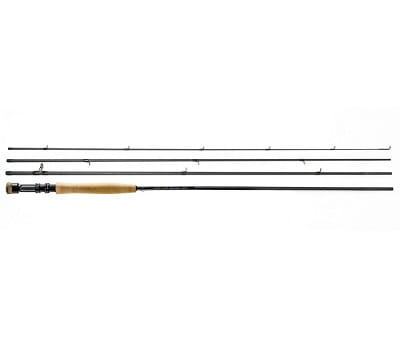
The best Euro Nymphing rod for steelhead is the 10-foot, 7-weight Cortland Competition MKII Fly Rod.
This rod is built for Modern Nymphing and I have used it many times and find it to be a great rod for the price as well as one of few rods that you will find in this length and weight. The balance of the weight and the main power in the butt section is perfect for nymphing steelhead.
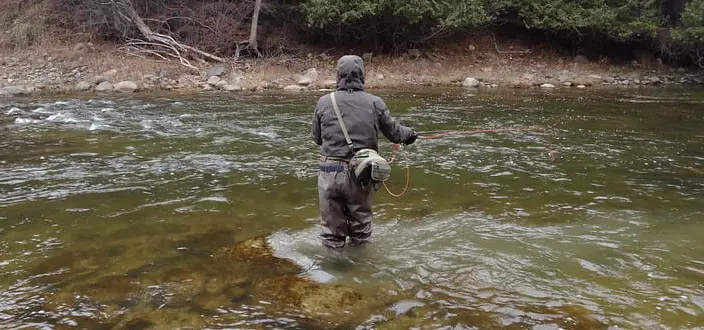
Jeff Blood Premium Steelhead Fly Rod
Another great rod for Euro nymphing steelhead around the Great Lakes Region, and a rod that is made by local legend and Great Lakes fishing guide, is the 10’3, 7-weight Jeff Blood Premium Fly Rod which sells for around $599.99 – Check Best Price.
This is a steelhead fly rod that could be used for both Euro nymphing and indicator fishing and is one of very few that are actually designed specifically for fly fishing steelhead.
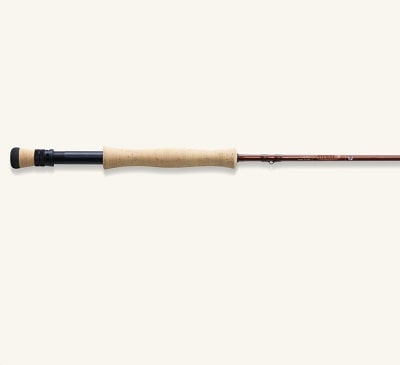
St. Croix Imperial USA Switch Fly Rod
Another rod that I have used for Euro Nymph fishing is the 11 foot 6 weight and 7 weight St. Croix Imperial USA Switch Fly Rod.
This is a lightweight switch rod and the extra length of the 11-footer is great for long reach and protecting light tippets.
Other good rods that would work for Euro Nymphing steelhead and for indicator nymphing for steelhead are:
- Douglas LRS Fly Rod 10 foot 6 or 7 weight – Average Price $189.00 – Check Best Price Now
- Temple Fork Outfitters LK Legacy Fly Rod 10 foot 6 or 7 weight- Average Price $289.00 – Check Best Price Now
- Orvis Recon 2 Fly Rod 10 foot 6 or 7 weight – Average Price 549.99 – Check Best Price
Do You Need A Special Fly Reel To Euro Nymph For Steelhead
All my euro nymphing reels for steelhead and for trout are normal standard reels. You do not need a special fly reel to euro Nymph for steelhead. However, I do recommend that you look at my page on the Best Fly Reels For Steelhead so that you get a good enough reel that can handle steelhead.
Weighted Flies
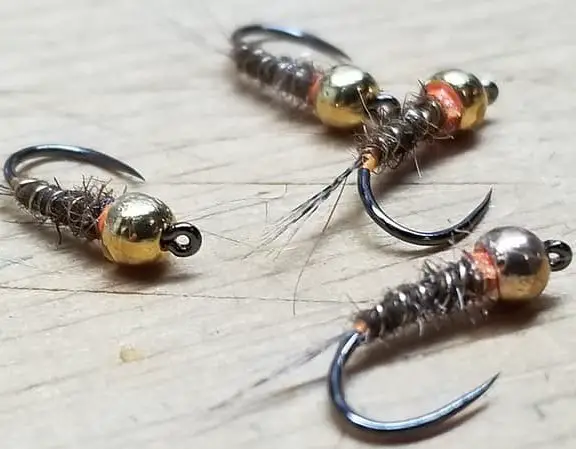
One of the things that makes Modern Nymphing for steelhead so effective is the use of weighted flies.
Weighted flies get your flies down fast and keep the line tight which greatly improves your bite detection. Even the most subtle bite is detected with this method.
To do this well, I use weighted flies. However, some of my best flies for steelhead can’t be weighted, but that doesn’t mean you can’t Euro Nymph for steelhead with them.
To see my most effective non-weighted flies for steelhead, check out my page on The Best Flies For Steelhead.
I will list some of my best Euro flies below.
Do You Need Weighted Flies Or Special Euro Nymphs?
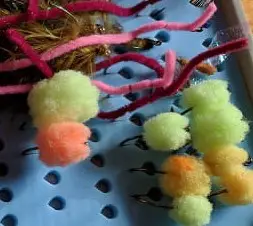
Some anglers shy away from Euro nymph methods because they have hundreds of non-weighted nymphs that they have tied or collected over the year and they think that they can’t use these non-weighted flies when Euro fishing for steelhead.
The truth is that you can use both weighted and unweighted flies when euro nymphing as long as you know my leader setups for both. I can even use 2 non-weighted flies at the same time, or I often use a combination of weighted and non-weighted flies on the same line with great success.
So the answer is no, you do not need weighted flies or special nymphs to euro nymph for steelhead if you know how to set up your flies and your leader properly.
I will show you and discuss the leader that I use for non-weighted flies below.
Euro Nymphing Leader Formula For Steelhead
To make my 16 to 24-foot Euro Nymphing steelhead leader, you will need a few things. Once you know what you need, I will show you how to build my leader below.
- 40 inches of 20-pound Maxima Chameleon Monofilament Leader – Check Best Price Now (FOR LONG MONO RIG GO UP TO 30 FEET – See my setup below)
- 40 inches of 16-pound Maxima Chameleon Monofilament Leader
- 3 to 8 feet inches of 12-pound Maxima Chameleon Monofilament Leader
- (Optional): instead of the 20lb and 16-pound section, you can use a 7 to 9-foot 0X tapered Leader – Check Best Price Now
- 12 to 36 inches long – Sighter – see below
- 3 to 7 feet – extra strong fluorocarbon tippet in sizes 1x, 2x, and 3x. Check Best Price Now – Length depends on the average depth of water.
- Tippet Ring – Check Best Price Now ( A Triple Surgeons Knot or a Double Uni Knot also works)
- Weights – Check Best Price Now
See the diagram below to put this all together.
My 2 Great Lakes Euro Nymphing Steelhead Leader Setups
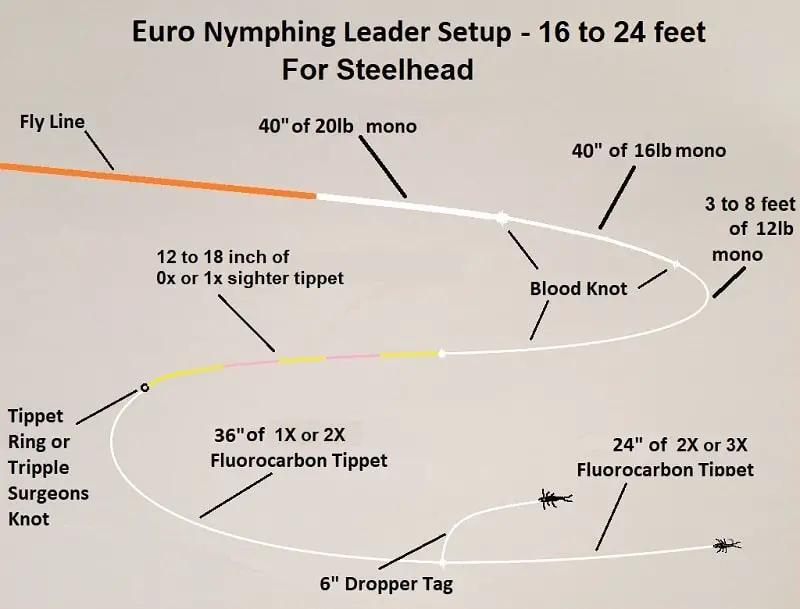
There are two ways I run this Steelhead Euro Nymphing leader setup.
One way is to use the Euro Nymph steelhead leader setup that you see above with the fly line tied direct to the leader. I generally go with the longer leader, so above where it says 3 to 8 feet, I tend to go to 8 feet.
The length will depend on your skill level. I tend to use a 12 to a 14-foot leader with absolute beginners until they are proficient with that length, and then slowly increase 2 to 3 feet at a time.
The second leader setup is a more advanced setup that I use for casting up to 40 feet without any fly line being used. However, anyone can use this setup and fish it short or long.
It’s different than the first Steelhead Euro Leader because instead of using 40 inches of 20lb mono at the top of the leader, I will run a 30 to 40-foot section of 30lb OPST Lazer Line between the fly line and the Euro leader.
I use the OPST for a few reasons, but the primary reason is that I can cast the entire leader about 40 feet, and since the OPST is much lighter than your fly line, it won’t sag and pull your fly toward you at an unnatural speed or angle.
If you cast that distance with a fly line it will sag and hit the water. However, the OPST will stay up and out of the water with the same amount of line out.
I will also use a double uni knot or blood knot for the Lazar line to mono connection.
For an even smoother knot that shoots through the guides easier and doesn’t get caught on the guides when fighting a fish, I use Loon UV Knot Glue to form a smooth football-shaped hard shell over the knot.
In fact, I use the Loon UV Knot Glue on any and all knots that may go into the rod guides when casting or fighting a fish and I highly recommend it to all my clients. I hope to have a video and photo of this knot soon.
With the OPST rig and some good casting, I can cast a single #10 euro nymph about 40 to 50 feet.
GUIDE TIP: You can do this same rig with just 30 to 40 feet of 20-pound mono, however, I have experimented with a number of different mono lines and many are too limp and they tend to get beat up easier. The OPST lasts a few years for me and casts well.
If you do decide to go with Mono, consider something like the Maxima Chameleon Leader spool of Mono. It tends to be a bit stiffer.
FYI: The leader that I use when tight-line Euro Nymph fishing for steelhead is similar or almost identical to what I use when Euro Nymph fishing for trout, and I use the same OPST line for trout, too. All I do for steelhead is upsize everything on the lower part of the leader or downsize everything for trout. I also use different flies that work well for steelhead.
I also tend to use longer casts with steelhead so with the OPST or Maxima Line, very little or no fly line is actually used.
What Lenght Leader Should You Fish With?
Although I can cast 30 to 40 feet of line to cover a lot more water, the amount of leader length out of the rod guides for a beginner should be 14 to 16 feet most or all of the time. It is very difficult to control the extra line, control the fly depth and speed, and detect bites with the extra long leader lines.
To be in good control and have a good hookset, the ideal length of leader (no fly line) outside the rod guides for semi-experienced anglers is 18 to 22 feet long. With the added OPST and better casting skills, you may cast and be in control with more.
Very experienced anglers and some of the top competition Euro Nymph anglers are known to cast 30 to 40-foot leaders with good control throughout the drift.
To get to this level, start short, get good at that length, and then add 2 to 4 feet, get good with that then add another 2 to 4 feet, and keep getting good and then adding 2 to 4 feet until you casting 30+ feet with good control throughout your entire drift.
Don’t rush and jump into 30-foot leader casts and then have sloppy drifts and no control, or you will miss fish.
Euro Nymphing Leader For Non-Weighted Flies
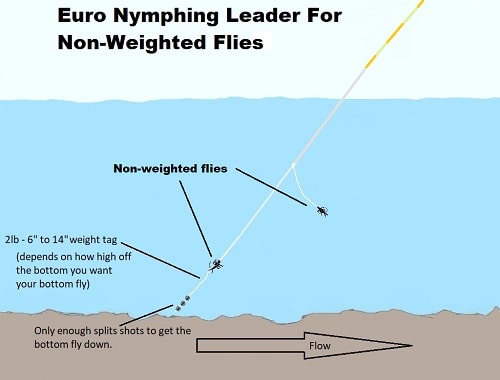
Some of my best steelhead flies like egg patterns and worm flies are not always weighted, and I know that many anglers don’t have weighted flies.
Therefore, some minor leader adjustments are required to get and keep the non-weighted flies down and the leader tight throughout the drift.
The key to Euro nymphing is to have the weight at the bottom so you always have controlled tension from the bottom of your leader to your rod tip.
This is why when I euro nymph with non-weighted flies I do not add weights like split shots to the upper parts of the leader, or anywhere between my flies or above my flies. Adding weight anywhere in the line could mean slack in the line below the weights and that can result in poor strike detection and missed steelhead.
Therefore, as seen in the diagram above, I always put my weight on a separate tag at the bottom of my leader and below the bottom fly.
The number of split shots I use will depend on the velocity and the depth of the spot that I am fishing.
Pre-Made Euro Leaders For Steelhead
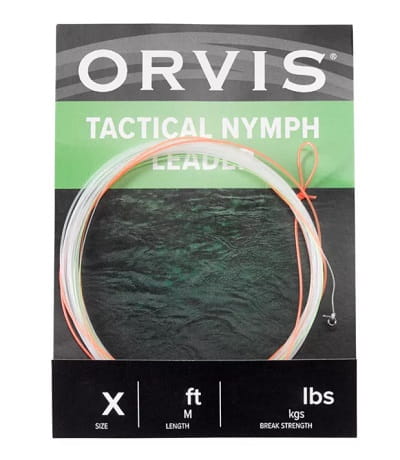
For anglers that don’t want the hassle of going out and buying all this stuff to make their own nymphing leader, I have used the 2X, 13-foot, Orvis Tactical Nymph Leader and the RIO Euro Nymph Leader with Tippet Ring, and although I don’t like it as much as my custom leader, it is still decent for most anglers, and it will do the job.
I have also used this for Euro nymphing for trout. You will still need a 2X or 3Xtippet for the bottom part of the leader.
The entire leader with the added 2X section of tippet is about 19 feet but the length will change based on the depth of the river that you want to fish.
Best Tippet For Euro Nymphing Steelhead
The best tippet size for Euro fishing steelhead in most great lakes rivers is 3X, but it will need to be an extra-strong high-quality tippet like the RIO Fluoroflex Strong Tippet.
Before you run out and get a heavy think line because you think the steelhead are big and that is what is required, remember that you will be using a 10 or 11-foot rod that helps protect your lighter tippets, and lighter tippets have some benefits and will help you catch more fish. I have landed thousands of Great Lakes steelhead on 3X tippets as well as hundreds on 4X tippets.
The three benefits of a lighter tippet and why I use light tippets are:
- #1. A lighter tippet will not get pushed by the surface current, and which will allow you to get a slower and more controlled drift.
- #2. A Lighter tippet will allow your flies to sink faster and get into the strike zone quicker.
- #3. A lighter tippet won’t be seen as easily by the steelhead and that will mean more fish will bite your flies.
I might use 4X in gin-clear water when steelhead are nervous and I have the room to walk a fish up or down the river and play them longer, but it’s pretty rare that i need to go this light.
I use a 3X tippet most often, and I do very well with it in very clear water. I use 2X tippet in bigger rivers or in semi-clear or in water that is stained. Going to a 2X is better for the fish and they won’t see it in off-colored water.
GUIDE TIP: A word of caution when using 2X tippet and flies that are purchased online or tied with some Euro Nymph hooks is that 2X is quite strong and if you have your drag tightened to the point just before the tippet will break, you may end up bending or breaking hooks, therefore, be sure to use the highest quality fly hooks, or loosen your drag just a bit.
I will rarely use 1X tippet, but if I do, it would be in large fast-flowing rivers like the Niagara River or the bigger west coast rivers, or in heavily wooded spots, and I would use extra strong hooks.
If I were going to buy a tippet today, I would buy RIO Fluoroflex Strong Tippet – Check Best Price Now.
Or if you are a guy like me who goes through a lot of tippets or you want to buy in bulk to cut costs, I would buy 6lb Sunline FC Super Sniper Fluorocarbon, which is equivalent to a 3X tippet. Check Price at FishUSA or Check Best Price at Bass Pro Shop
GUIDE TIP: Your Sighter, leader, and tippets are only as good as your fly knots. Are you using good knots? I’ll tell you my Best Knots at his link.
Euro Nymphing Flies For Steelhead
Part of what makes Euro fishing for steelhead so unique and so effective is the use of weighted flies, which allows for a semi-tight line which then aids in great strike detection.
The weighted flies also allow you to get your flies into the strike zone quickly and then keep them there. But, some of my best steelhead flies can’t be weighted, or shouldn’t be weighted because I want them to act and drift freely or naturally.
Therefore I will make minor adjustments to my leader (as seen above) which includes where I place those non-weighted flies on the leader.
Best Euro Nymphs For Steelhead

Most of my Euro Nymph flies are custom tied by me. I did some research for you guys and found patterns that are similar or exactly the same as the ones that I use and that work well for me.
I prefer to use flies in size 10 or 12 for steelhead, however, depending on conditions, a size 8 or 14 can be good.
The Best Euro Nymphs For Steelhead Are:
- Walts Worm and Sexy Walts Worm are two of my most productive Euro Nymphs – Size 12 – Buy Now
- Tungsten Jig Fly – Size 12 and 14 – Buy Now
- Peeping Caddis Jig Fly – Size 12 – Buy Now
- The Frenchie – Buy Now
- Hares Ear and Hotspot Hares Ear Nymph – Buy Now
- Tungsten Mop Jig Fly – Good in multiple colors – Size 10
- The Polish Pheasant Tail Nymph is one of my favorites for euro fishing for steelhead. Buy Now
- Bead Head Black Stonefly – Buy Now
- Rainbow Warrior fly – An attractor pattern that works for steelhead – Buy Now
- Higas SOS fly has been good the last couple of years for Steelhead – Buy Now
- Hares Ear Wet fly Nymph- Buy Now
- Tungsten San Juan worm or Squirmy wormy – Buy Now
- Tungsten Micro Wooly Bugger – White, Black, and Olive are my most effective colors in sizes 10 and 12.
- Tungsten Jigged Prince Nymph – One of my most effective patterns in the spring and early fall. Size 10 or 12.
- Tungsten Duracell Jig Head Fly
- Tungsten Jigged Caddis
- Tungsten Bead Frenchie Jig Fly
NOTE: I tie my own flies on high-quality hooks that I know will not break or bend, but the hooks from mass-produced fly companies are often not high quality, so when buying flies you do so at your own risk, especially if you buy cheap flies.
Often, discount flies are only good for little trout.
Also, the patterns I recommend are either exactly what I use or as close to my exact patterns as I could find that are available for you to purchase. The flies do not need to be an exact match to the ones that I use as long as they are very close and you fish them well.
For quality hooks and some fantastic custom flies that myself and my clients have used, check out The Fly Feind.
Bead Size / Hook Size Reference Table
| Bead Size | mm | Use Hook Size |
|---|---|---|
| 1/16″ | 1.5 mm | 18 – 20 – 22 |
| 5/64″ | 2 mm | 16 – 18 – 20 |
| 3/32″ | 2.3 mm | 14 – 16 – 18 |
| 7/64″ | 2.6 mm | 12 – 14 – 16 |
| 1/8″ | 3 mm | 10 – 12 – 14 |
| 5/32″ | 4 mm | 8 – 10 – 12 |
| 3/16″ | 4.5 mm | 6 – 8 – 10 |
| 1/4″ | 5 mm | 4 – 6 – 8 |
Euro Nymphing Styles And History – Better Methods
The methods of European Nymphing on this page are proven to work on great lakes steelhead, but they are my versions of Nymphing.
Euro nymphing can mean different things to different people because there are many styles and variations of Euro nymph methods. You may have heard of Czech Nymphing which is just another European style of nymphing, and it can be very effective at times.
I will change Nymphing styles for different types of water and doing so allows me to adapt or adjust to a method that can work better based on the spot, and that and helps me catch more fish. But you can’t adapt if you don’t know what to change too.
How To Euro Nymph – How You Actually Do It
There are many so-called Euro Nymph experts, but few actually are. I have been lucky enough to learn from multiple competition fly anglers and even world champion fly anglers, so it’s easy for me to spot the fakes and the real experts.
Since it’s pretty hard to explain the cast, the drift, and just how to Euro nymph, I know it’s sometimes better to watch it done, but be sure you watch it from the right guys.
I hope to have a video series out soon, but in the meantime, these are two great options to see experts at modern nymphing and Euro Nymph fishing.
The closest method to what I use can be seen in the video called Modern Nymphing, which is the best video I have seen on this method.
I have spent days on the water training with Euro Nymphing guru George Daniel, and I can honestly say that he is one of the best anglers I have trained with.
George has a free YouTube video that explains and shows you how to euro nymph properly. His methods are also very similar to the methods that I use for steelhead. Watch George Euro fishing Here and enjoy watching a master in action.
If Euro Nymphing is not for you, make sure you check my page on Nymphing For Steelhead to see other great methods for catching steelhead.
Tight Lines
Graham
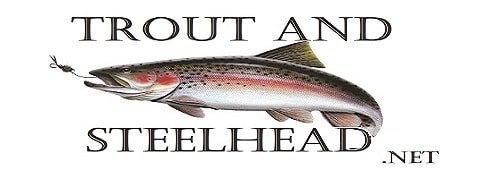

Hi Graham,
Which would be the lightest line wt Orvis Clearwater nymphing rod you recommend for Lake Erie tributary steelhead? I understand the average wt for Erie steelhead is 4-6 lb and can go up to 10lb. I am trying to see if I can use one of those Clearwater rod for both trout and steelhead so that I can get dual use out of it efficiently.
Thanks.
Nick
Hi Nick, unfortunately, there is not a perfect rod for both. The lightest I would go for steelhead would be a 5 weight rod which would be a bit light for steelhead and a bit heavy for small trout but would work for both. if you wanted to be sure you had a rod that could handle the steelhead, you could also go to a 6 weight rod which should be a good rod for steelhead of 2 to 6 pounds and it would just be just a bit heavy for trout, especially small trout like you 6 to 10-inch trout.
Unless I was fishing little 4 to 8 inch brook trout a lot more than steelhead, if it was me, I would go for a 6 weight.
Hope that helps,
Hi Graham,
Thank you for the prompt reply. The information is very helpful.
Nick
Hey Graham,
I was wondering if you could explain in your opinion why using an indicator in slower deeper pools is better than euro nymphing? I have a trip coming up soon and really want to winter euro nymph, as an alternative, what are your thoughts on tight line to the indicator fishing? Taking my euro mono rig and just adding a 3gram float? I have a centerpin setup, but really prefer the lightweight euro setup…I also don’t have a ton of interest in fishing long distances below myself as it isnt as effective anyways. Do you think a tight line to the indicator method with a float would be just as effective as my centerpin? I figure I can fish up 35 feet out and then just feed extra mono if I want a longer drift, But keeping most line off the water when possible increases that connection. I am thinking a couple split shot right under my float, a heavily weighted fly on dropper down to a light weighted or unweighted fly on point…Would love to hear your thoughts on this!
Best,
Jeremy
Hi Jeremy,
The reason that Euro nymphing is often so effective is because of the angler’s ability to have the flies move at a slower more natural speed in the current, as well as being able to control your depth at different parts of the drift. As soon as you add an indicator, the surface current which is usually faster than the bottom current will pull the indicator and will pull the fly abnormally fast. Even if you tight line it to the indicator, the current will still pull the fly abnormally fast. That doesn’t happen without the indicator with true euro nymphing. And if you are standing downriver and casting upriver you can not control the speed on the indicator.
As far as why indicators are better in slow water it’s simply because sometimes there is not enough speed to move the fly along efectievly when not using the indicator and many anglers struggle with euro nymphing in slow water. An indicator is just easier.
Hope that helps
Graham
Hi Graham, I just wanted to drop a quick line to say that I really appreciate all of this information and insight. I’ve cross-referenced this page a few times, while getting geared up for the spring. Cheers, Cam
Hi Graham,
Thanks for all of the info on this site. I am looking at setting up one of my rods for euro nymphing steelhead and I just want to make sure I am doing the mono-rig set up right.
You mention using 30 pound green Lazar line and attaching that directly to your normal steelhead line. After that do I make one of the mono leaders from the diagram? (steelhead line > 30lb Lazar > leader) or do you make the leader using the 30lb lazar and go straight from the steelhead line to the leader?
If it’s the first option, then how much 30lb lazar do you put on before the leader?
Thanks
Hi Matt,
I’ll be revising this article to make it more clear, I’ve just added extra with more to come. For now, run 30 to 40 feet of OPST Pure Skagit Lazar Line to 8 to 12 feet of 12 pound mono, then to your sighter. Use a double uni knot or blood knot for the Lazar line to mono connection, and for a smoother knot that shoots through the rod guides easier, I use Loon UV Knot Glue to form a smooth football-shaped hard shell over the knot. I hope to have a video and photo of this knot soon.
With that rig and some good casting, I can cast a single #10 euro nymph about 30 to 40 feet. Hope that helps.
Graham,
Hi Graham,
Great site and thanks for all the info. I have been fishing a mono rig on trout streams for a few years now and can’t wait to try it out on steelheads. My concern is with the leader to fly line connection. Im guessing it’s a loop to loop and I doubt u put UV resin on that. When you hook up I’m sure the fish takes you into the fly line. Do you have any issues with that connection going through the guides when fighting the fish? This is the only reason I’m thinking about getting a euro fly line.
Thanks again,
Tanner
Hey Tanner,
To be honest, I hate the fly line loop to leader loop connection, so I cut my fly line loop off and use a nail knot with UV to smooth it out..
Because yes, that loop to loop connection can be a major issue.
However, if you don’t want to cut the fly line loop, my tip is: the loop is only an issue when your rod is bent with lots of pressure on the line, the knot sticks in the guides and the top 3 tips are usually the biggest issue, so, when the knot is coming out of the reel and into the guides, lower your rod and point the tip directly at the fish, this takes most of the pressure off the guides and the loop connection should slide through without sticking, once that loop is out of the guides, put a bend in the rod again, you may need to do this a few times during the fight, but it does work…
Good Luck,
Graham
Hi Graham,
Loved all the shared experience in your article on euro nymphing for steelhead!
I had one question: I’m from Oregon and wanted to know if these techniques can be used successfully on the west coast rivers like the Willamete, Sandy, and some of the coastal rivers like the Wilson, Siletz, etc.?
Thank you,
Bruce
Hey Bruce,
From what I know of those rivers, yes, you would be able to Euro nymph them in any sections with medium to fast flows that are under 8 feet deep. The deal water is less than 6 feet deep. 3 to 6 feet is great and it’s great for very clear water. Slow water is tough, that’s when I might add an indicator.
Best Of Luck
Graham
If anyone is looking for a great Euro nymphing fly rod try the new Diamondback 10’10” 6wt, I have used it and have no problem with sensitivity, protecting lighter tippet and being able to handle 10lb plus steelhead. It fishes and handles better than any other Steelhead rod I ever fished.
Good to know, I will need to check that out one out. Thanks for the input.
Graham
Hi Graham! Fantastic article! What size tungsten beadheads on a size 10-12 hook do you use to get the fly down to the bottom? I’d imagine try a fly with a big bead would look silly and unnatural. Thanks!
Good point.. I have just added a bead / hook table for you and other readers. However, you might be surprised at some of the bead head flies the competition anglers use and how big the beads are compared to the hook, and they still catch plenty of fish on them.
Good luck,
Graham
Really informative page, thank you. This method sounds like drift fishing with tackle, or basically Tenkara with a reel. I might give it a try at some point.